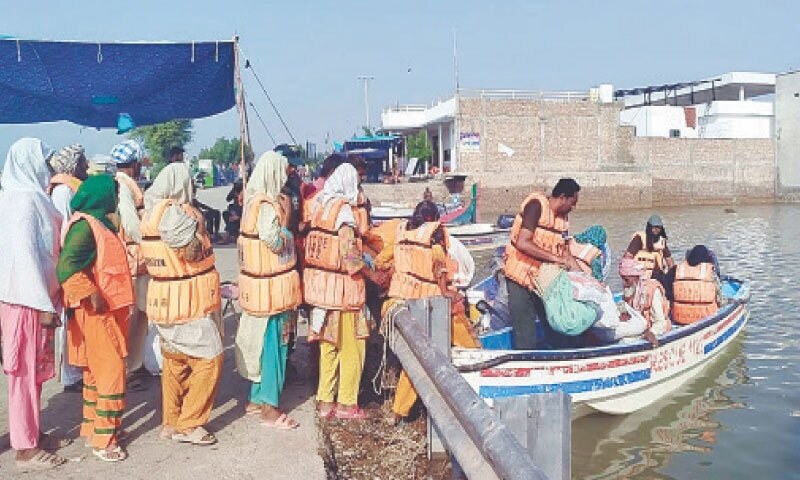• The worst 1.3 million hectares in Punjab, including most farmland, are absorbed
• Reported feed shortages and increased risk of disease
• PDMA orders investigation to prioritize public complaints; displaced persons were told to evacuate Jalalpur Pirwala’s school as classroom
• There are office forecasts of rain, wind, thunderstorms in southeast Sindh province until October 2
Islamabad/Lahore: Food and Agriculture Organization (FAO) warns Flood loss In Punjab and Khyber-Pakhtunkwa, the Punjab Disaster Management Bureau directed the investigation team to affect the upcoming rabbi farming while assessing the losses in the affected areas.
Meanwhile, the Pakistan Meteorological Department (PMD) predicted rainfall, wind and radar in southeast Sindh province, and the occasional gap occurred until October 2.
Recent floods have damaged farmland, crops and agricultural infrastructure in Punjab and Khyber Pakhtukhwa.
In a preliminary assessment of the impact of floods released on Monday, the FAO warned that the seeds of Rabi 2025-26 and Kharif 2026 were at risk.
Floods flooded 1.3 million hectares, including 930,000 hectares of farmland, the worst in Punjab.
FAO said half of the wheat seeds came from preserved cereals, most of which were lost in flooded homesteads.
In the formal sector, between 80% and 90% of wheat seeds are available, but market pressures may affect this supply. Rising demand and prices may prompt farmers to sell seeds as cereals, reducing availability in provinces.
The report said flooding reduced feed supply, increased costs and limited access to remote areas.
Many livestock owners are turning to distress sales, while only 45% of feed seeds are available in the formal market, which increases the risk of livestock nutrition. Crowded shelters and stagnant water are high stress and disease risks for livestock.
FAO warns that conditions favor outbreaks of mass skin disease (LSD), foot and oral diseases, Pest de Petit ruminants (PPR) and other zoonotic infections. The LSD outbreak has been reported in Punjab, which borders Sindh and Bal Luchistan provinces in the southern part of Punjab, and is spreading northwards, with new cases in Pakpattan, Lodhran and Khanewal.
The FAO report said that the quantified crop damage in Punjab was: Rice: 188,837 hectares of damage (7.3% of total rice area), mainly in the northeast. The most severe regions are Sialkot (37,944 HA, 24.67pc), Narowal (20,008 HA, 15.88pc), Gujranwala (10,765 HA, 4.72PC), Bahawalnagar (Bahawalnagar (9,594 HA, 8.60pc) and Sheikhupura (9.594 HA, 8.60pc) and Sheikhupura (9.36 HAH).
Cotton: 84,182 hectares of damage (5.1% or total cotton area). The hardest hit areas were Bahawalpur (19,503 HA, 6.10pc), Rajanpur (8,688 HA, 6.75pc), Khanewal (7,724 HA, 8.21pc), Multan (6,917 HA, 7.57pc) and Muzaffargarh (6,917 HA, 7.57pc) and Muzaffargarh (Muzaffargarhh (6.477777777777777) HA, 7.03pc).
Sugar cane: 23,413 hectares of damage (2.8% or total sugar cane area). The most affected areas are Faisalabad (2,466 HA, 4.01pc), Jhang (2,254 HA, 4.05pc), Bhakkar (2,201 HA, 6.28pc), Rajanpur (1.512 HA, 2.87pc) and Layyah (1,512 HA, 2.87pc) and Layyah (1,504 HA, 5.45pc).
In KP, 62,080 hectares of land were flooded, including 50,821 hectares of farmland (2.7% or total farmland). In Sindh, 74,542 hectares of land (0.5% or land) were flooded, including 43,140 hectares of farmland (0.8% or total farmland).
“Focus on complaints”
Meanwhile, the Punjab Disaster Management Authority has ordered the investigative team to focus on evaluating public complaints to assess areas damaged by floods.
In Jalalpur Pirwala, people were asked to evacuate schools used as relief camps so that courses could be restored.
PDMA has released water level data for all rivers in Punjab, showing a significant drop in normal flows and flood-affected areas.
Additionally, PMD predicts rain, wind and thunderstorms in southeast Sindh province until October 2, with occasional blanks.
Aamir Yasin of Rawalpindi also contributed to the report.
Posted at Dawn on September 30, 2025



